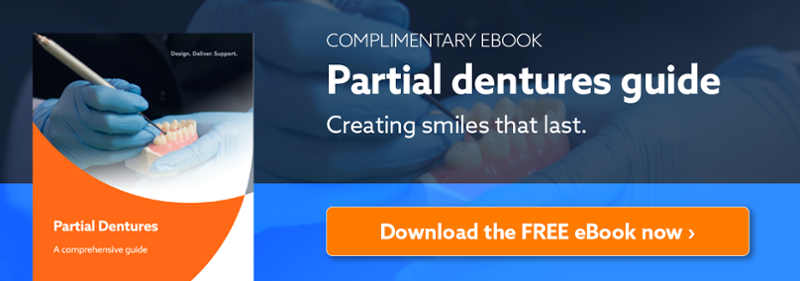Fabricating a partial denture that delivers excellent esthetic and functional results takes meticulous planning. There are several steps that need to be completed to achieve a great outcome.
Step 1: Accurate Impressions
It’s essential to take accurate impressions and an accurate bite. A well-designed removable partial denture considers the entire arch of all teeth, not just the ones that are missing. To do this we need to fully assess any problems within the arch. It is often useful to send a correct occlusal surface bite.
These impressions are poured in high-quality gypsum stone as they must be strong enough to stand up to being articulated. Ideally, the articulator should be anatomically sized, allowing for smooth movements in all directions.
Step 2: Assessing the Bite
Next, the models must be assessed with attention to the contact point between the teeth to see if any adjustments are required. Assess the bite for placement of occlusal rests. If needed, prep the natural tooth surface where occlusal rests need to be placed. If interocclusal space is limited then the bite may need to be opened slightly and reduction of opposing teeth may be necessary. Metal linguals or metal occlusals may also be needed.
A surveyor is used to mark the height and contour of the teeth that will be involved in the frame design, clearly highlighting any path of insertion problems. Sometimes a dentist will choose to survey the models themselves, but other times they will ask for assistance from a dental technician accustomed to using a surveyor.
When surveying a model, there are several issues that must be considered. First, the surveyor should be used to mark the height of contour on all the teeth that will be involved in the frame design, which will clearly show any problems with undercuts. Tooth surfaces that require guide planes may be paralleled in the mouth to reduce heavy undercuts.
Step 3: Clasp & Flex
Clasp design is based on the Kennedy classification of the arch and the different levels of undercuts that may or may not be present. The flexible cosmetic clasps or tooth-colored clasps are great options for maximum esthetics.
Step 4: Final Step Before Processing and Finishing
The bite will be analyzed for proper design. Design involves the Kennedy classification, the path of insertion, undercuts, and esthetics. The frame will be fabricated via the lost wax method. The final product will be ready to have teeth set in wax for a try-in to ensure bite and esthetics prior to final processing.
Please be reminded that should you wish to discuss a case in more detail, our experienced technical team is here to assist you.
Click here to schedule a consultation with our technical team ›
